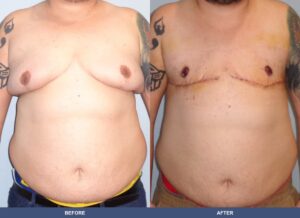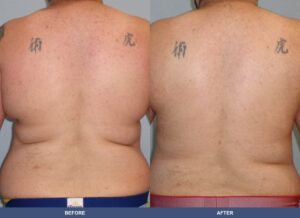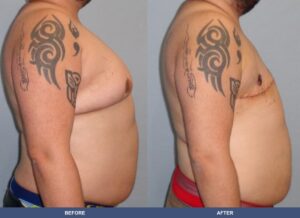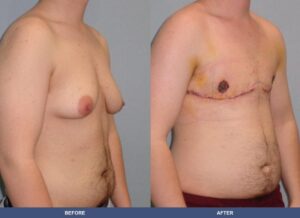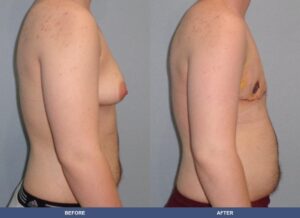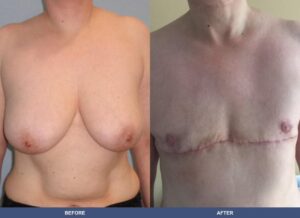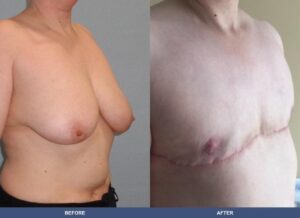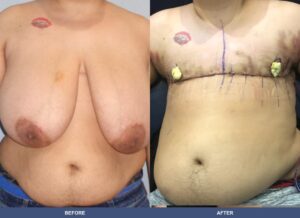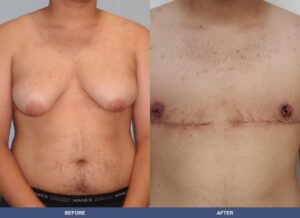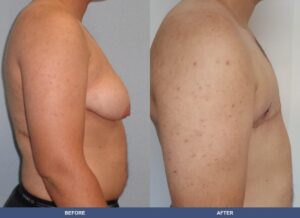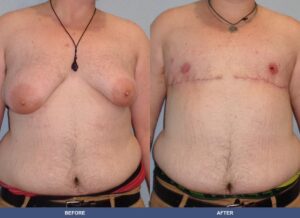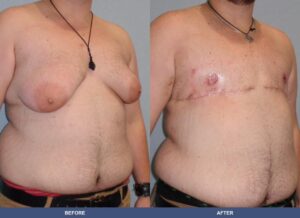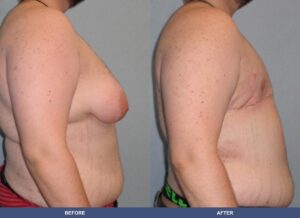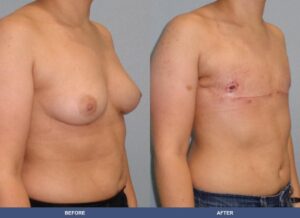“FTM Top Surgery” is a term used for various procedures performed for chest masculinization surgery for transgender men, including “Double Incision with Nipple grafts”, “Periareolar”/”Keyhole Mastectomy”, “Inverted-T”, and “Buttonhole Top Surgery”.
FTM Top Surgery includes removal of the breast tissue and contouring of the chest to achieve a masculine appearance. FTM Top Surgery can also include liposuction and nipple/areola resizing and repositioning using free nipple grafts. FTM Top Surgery is typically done under general anesthesia as an outpatient procedure.
FTM Top Surgery procedures have been found to have a low complication rate and a high satisfaction rate. The procedures have been effective in reducing gender dysphoria and improving quality of life.
Double Incision with Nipple Grafts (DING)
DING is the most common form of FTM Top Surgery. Generally speaking, it is the most effective and reliable option for the majority of patients. The procedure includes horizontal incisions in the region of the breast fold which results in two scars just below the pectoral muscles. The scars can extend laterally along the chest wall in patients who have excessive skin in this area. The procedure includes removal of the nipples and areola from the breast, resizing of the nipple and or areola if needed, and grafting the nipple and areola at the appropriate anatomic location.
Liposuction of the chest, lateral chest and even the upper back region may be done as part of the procedure to achieve the best result. Patients considering this procedure should take into account the length of the scars and the likely loss of nipple sensation with the nipple grafts.
Periareolar/Keyhole Mastectomy
Patients who have smaller breasts may choose to have either a Periareolar or Keyhole Mastectomy. The Keyhole Mastectomy is performed in patients who have no excess skin, through a small incision at the outer edge of the areola. A complete sub-cutaneous mastectomy is performed through this incision. Liposuction of the chest may also be done as part of the procedure. If there is a small amount of excess skin then a complete peri-areolar incision is made. A small circle of skin is excised. A subcutaneous mastectomy is performed. The outer edge of the skin is closed with a purse-string suture to the newly down-sized areola.
Potential issues with these procedures include not being able to tighten the skin as much as with the DING procedure, pleating or bunching of the scar around the areola with a possible need for future scar revision, and loss of the nipple if it does not retain enough blood flow. The nipple position cannot be controlled or changed by Dr. Wigoda. There may be limits regarding whether the nipple or areola can be reduced in size at the same time. Numbness of the nipple is also possible. The primary benefit is less visible scars.
Inverted-T and Buttonhole Top Surgery
There are other less common procedures for Top Surgery. The Inverted-T is designed to preserve nipple sensation. The procedure requires saving breast tissue to keep the areola and nipple vascularized. The benefit of the procedure is that there is no grafting of the nipple and there is a greater possibility but no guarantee that sensation will be preserved. The disadvantage is a vertical scar from the nipple to the lower scar, a potentially larger breast since some breast tissue must be preserved, and the inability to place the nipple exactly where you would like. The buttonhole procedure is essentially the same as the Inverted-T without the vertical scar. Neither of these procedures is likely to be the optimal procedure for most patients.
FTM Top Surgery Scars
The resulting scars after these procedures are certainly a topic that needs to be and will be discussed with Dr. Wigoda. With that being said, the majority of patients are much happier after surgery than before surgery, regardless of the scars. Dr. Wigoda will make every attempt to create the shortest possible scars while providing the best possible contour. For the DING procedure, the scars will end up along the region of the breast fold and may extend laterally along the lateral chest, depending on the patient’s anatomy.
At the completion of the procedure, the incisions will be sutured as a thin line. Patients will be encouraged to use scar treatments to optimize the result. However, everyone heals differently. The width, color, and thickness of the scar will vary from one person to another depending on their own genetics along with their compliance with using scar products, avoiding the sun, and following post-operative instructions. It will take one to two years for the scar to mature and to see what the final scar will look like.
FFM Top Surgery Revisions
Patients who have had FTM top surgery done elsewhere may wish to have a revision of their chest. Some patients may not have had the optimal procedure done for them or the procedure they had was not done well. Dr. Wigoda is willing to evaluate these patients to see if their results can be improved. In some cases, it may be a minor correction that can be done under local anesthesia but in others, it may be more involved and require general anesthesia.
Body Masculinization Surgery
Many patients will request to have Body Masculinization Surgery procedures done during the same surgery as the FTM Top Surgery. Most patients will be candidates to combine these procedures in one setting. The benefits include one recovery period, one trip if the patient lives out of the area, and some savings in the cost of the combined surgeries as compared to costs if done separately. The most common procedure includes Power Assisted Liposuction to masculinize the body. Areas that may be of concern include the back, abdomen, hips, flanks, buttocks, and inner/outer thighs.
For patients with excess skin in the lower abdomen, a tummy tuck (abdominoplasty) can also be considered. The cost of the liposuction will vary depending on the number of areas and the amount of fat that needs to be removed
Surgery Requirements
- The patient must be in good health. Patients who have medical issues may be candidates as long as their medical issues are well controlled (for example, high blood pressure, diabetes, hypothyroid, etc).
- Support letter(s) from qualified mental health professionals, written to WPATH standards.
- Dr. Wigoda will operate on minors aged 16 and up with parental consent.
- No nicotine products (cigarettes, vaping, nicotine gum or patch, etc) for at least 6 weeks prior to surgery.
- No aspirin or aspirin-containing products for three weeks prior to surgery
Paying for Surgery
Dr. Wigoda accepts cash, credit card, or medical financing. He does not accept insurance, Medicaid, or Medicare. After surgery, if you wish to submit a claim to your insurance we can provide you will a letter and a copy of the operative report. The cost of the surgery will vary depending on exactly what procedure will be done and how long the procedure may take. If you complete our virtual consult with photos, we can give you an estimate via email. The surgery will usually be performed in our outpatient surgery center. Dr. Wigoda does have privileges at local hospitals where the surgery can be performed if the patient prefers a hospital setting or overnight hospital stay (this is not common or necessary but is available).
Scheduling a Consultation
For patients who live locally: For an in-office consultation, the easiest way to schedule is to simply call the office at 954-463-7088. The consultation is free. If you would like to do a virtual consult before coming to the office that is perfectly fine. Please fill out the virtual consult form and submit photos. Dr. Wigoda will evaluate the information and reach out to you himself.
For out of town patients: It is best to start with our virtual consult form (link to virtual consult). Please fill this out and include photos. Dr. Wigoda will email you back with his thoughts and opinion and will be happy to answer any questions.
The Recovery Period
Patients will be provided with prescriptions and detailed instructions for their recovery after surgery. Patients will generally need to return to the office the day after surgery to be checked and have the dressing changed. For local patients, there will be multiple follow up visits over the next few weeks. For out of town patients, it is ideal that they stay in town for at least one week. Dr. Wigoda encourages patients to stay at the New Beginnings Retreat (http://newbeginningstlc.org/) where the staff is very experienced in taking care of FTM patients.
They will provide transportation to the office. Dr. Wigoda has extensive experience in “painless surgery” techniques. For most patients, there is minimal pain and discomfort. Patients are restricted from exercising, heavy, lifting, and swimming for at least four weeks. Patients are able to raise their arms immediately after surgery.
Complications
Complications are not common but are possible with any surgical procedure. For FTM top surgery these include bleeding, infection, nipple complications (loss of all or part of the nipple, loss of sensation, hypersensitivity, and loss of pigment), contour deformity, and unattractive scarring.



